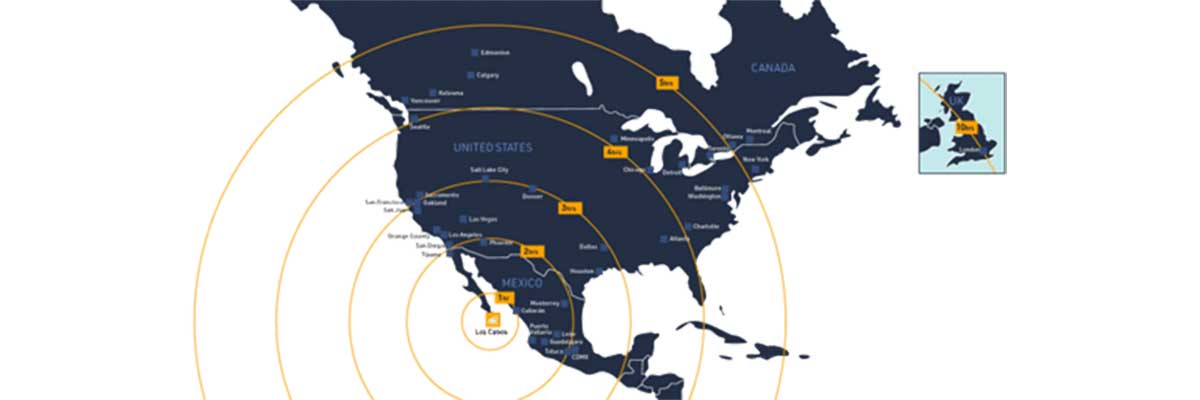Where is Los Cabos?
Los Cabos is located just below Southern California on the southernmost point of the 1,000-mile-long Baja Peninsula, west of mainland Mexico. Los Cabos is bordered by the Sea of Cortez on the east and the Pacific Ocean on the west. About 1,609 kilometers (1,009 miles) separate Los Cabos from San Diego, California.
It offers great flight connections to the major US, Canadian, and Mexican destinations.
Airport Details
Just 8 miles to the north of San Jose del Cabo and 23 miles from Cabo San Lucas is where you'll find the Los Cabos International Airport (SJD). Around 40 locations are served by the 550 weekly operations in Los Cabos.
Welcomes private and charter flights, both domestically and internationally. To enter Mexico, your passport must be current. All travellers must go through immigration and customs when traveling abroad. Pick up your luggage and head to customs after you've passed immigration. Here, visitors press a button on a figurative traffic light; if it goes red, their luggage has been selected for inspection. It's possible that timeshare salespeople will welcome you when you pass through the customs and immigration section. Outside the building, cab drivers and pre-arranged transportation companies will be waiting. Yellow and white mini shuttles are your best alternative because they're less expensive than taxis unless you've prearranged pickup from your hotel.
You might have to wait a while because they won't go until they are completely full. The Cabo San Lucas International Airport (CSL), which accommodates largely private aircraft, is another smaller, less used airport. It is only ten minutes from Cabo San Lucas's city center. Aeroméxico, Air Canada, AirTran, AirTransat, Alaska Airlines, American Airlines, Southwest, Delta, Frontier, Interjet, Spirit, Sun Country, Sunwing, United Airlines, US Airways, Virgin America, VivaAerobus, Volaris, and WestJet all provided flights to Los Cabos as of the time of publication. Numerous American cities, including Atlanta, Charlotte, Chicago, Dallas/Fort Worth, Denver, Detroit, Houston, Kansas City, Missouri, Minneapolis, Newark, Phoenix, Salt Lake City, and Seattle, provide nonstop flights or simple connections to Los Cabos. Flights and connections are accessible from California's Los Angeles, Orange County, San Diego, San Francisco, and San Jose. Flights are accessible from Canadian cities like Calgary, Edmonton, Kelowna, Toronto, Vancouver, and Winnipeg.
Airline Telephone Numbers
International: USA: Los Angeles, Dallas, Phoenix, Chicago, Charlotte, Austin, Sacramento, San Diego, San Jose, San Francisco, Orange County- Santa Ana, Seattle, New York JFK, Atlanta, Minneapolis, Salt Lake City, Detroit, Denver, Houston, Newark, McCarran and Cincinnati.
Domestic: Mexico City, Guadalajara, Monterrey, Tijuna, Leon /El Bajio, Culiacan, Hermosillo, Los Mochis and Mazatlan.

About Los Cabos
The majority of visitors to the Los Cabos area are intimately familiar with the wild nightlife of Cabo San Lucas or have experienced the cool breezes along the sleepy stretch of San Jose del Cabo, but many are unaware of the rich and illustrious history of the indigenous culture that permeates the Baja landscape.
The Pericues, Guayacaras, and Cochimes were three tribal groups that the early Spanish invaders of Mexico came into contact with. Cave paintings can be found all across the area, but particularly near the Misión de San Jose, Plaza Amelia Wilkes, and El Faro Viejo lighthouse. These paintings depict native life and culture. Over the years, more than 50 locations have persisted. Mural painting trails can be found, particularly in Miraflores and Los Barriles.
Hernan Cortez, a conquistador from Spain, tried to colonize the peninsula in 1535, but he failed because of hostilities and the inability to cultivate crops. The Spanish Jesuit missionaries arrived in the Baja region after 150 years to spread religion, founding several missions that are still accessible today: Misión Santa Rosala de Mulegé (1705), Misión de Nuestra Seora de Loreto Conchó (1697), Nuestra Seora del Pilar de la Paz (1733), and Misión Estero de las Palmas de San José del Cabo Auit (1730).
A stroll through any of the alleys of Miraflores or Santiago will transport you back in time to a more simpler era. Wonderfully lovely hinterland communities capture the indigenous heritage. When you return, spare a thought for the region's history and appreciate its age.









